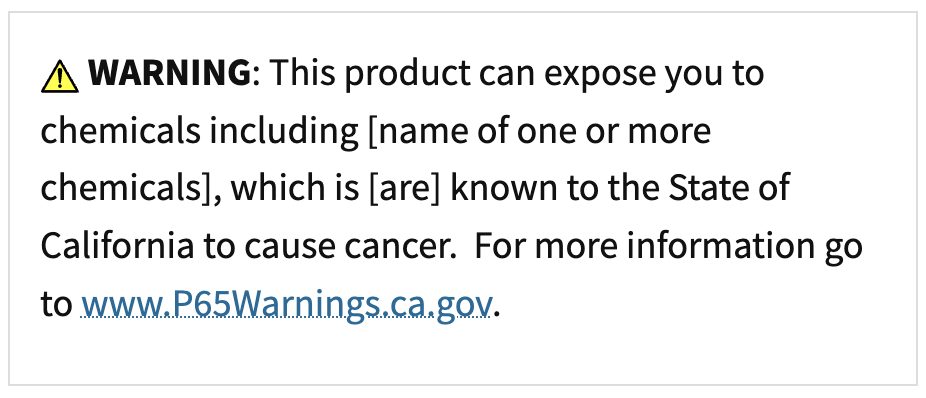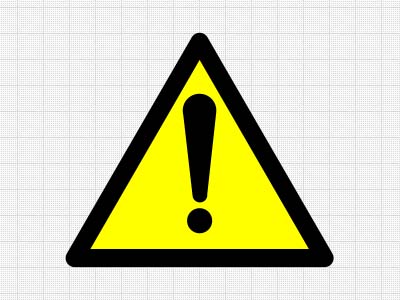As we discussed in our previous article, Proposition 65 is a Californian law that requires businesses to warn the public about certain chemicals in the environment and consumer goods, with the goal of protecting the state’s drinking water sources.
Proposition 65 is a California law that states that “A person in the course of doing business, who manufactures, produces, assembles, processes, handles, distributes, stores, sells, or otherwise transfers consumer products which are known to contain a chemical known to the state to cause cancer or reproductive toxicity in an amount that requires warning shall provide a warning to any person to whom the product is sold or transferred unless the product is packaged or labeled with a clear and reasonable warning.”
To comply with Proposition 65, businesses are required to provide a clear and reasonable warning before exposing anyone to the listed chemicals. In late 2016, the State of California amended the warning language and methods that are deemed “clear and reasonable” under the statute (i.e., that provide a “safe harbor” from enforcement). These amendments became effective on August 30, 2018.
Exemption
Businesses with fewer than 10 employees and government agencies are exempted from Proposition 65’s warning requirements and prohibition on discharges into drinking water sources. Businesses are also exempted from the warning requirement and discharge prohibition if the exposures they cause are so low as to create no significant risk of cancer or are significantly below levels observed to cause birth defects or other reproductive harm.
Administration and Enforcement
The Office of Environmental Health Hazard Assessment (OEHHA) is the legal agency responsible for the implementation of Proposition 65 regulations and administers the Proposition 65 program. OEHHA, which is part of the California Environmental Protection Agency (CalEPA), determines in many cases whether chemicals meet the scientific and legal requirements for placement on the Proposition 65 list, and administers the regulations that govern warnings and other aspects of Proposition 65.
The California Attorney General’s Office enforces Proposition 65 and any district attorney or city attorney (for cities whose population exceeds 750,000) may also enforce Proposition 65. In addition, any individual acting in the public interest may enforce Proposition 65 by filing a lawsuit against a business alleged to be in violation of this law. Lawsuits have been filed by the Attorney General’s Office, district attorneys, consumer advocacy groups, and private citizens and law firms.
OHEEA and Safe Harbor Levels
To guide businesses in determining whether a warning is necessary or whether discharges of a chemical into drinking water sources are prohibited, OEHHA has developed safe harbor levels. A business has “safe harbor” from Proposition 65 requirements if exposure to a chemical occurs at or below these levels. These safe harbor levels consist of “No Significant Risk Levels” for chemicals listed as causing cancer and “Maximum Allowable Dose Levels” for chemicals listed as causing birth defects or other reproductive harm.
OEHHA has developed safe harbor levels for roughly 300 of the more than 1000 chemicals on the Proposition 65 list. If the product exposes an individual to a chemical at a level below the maximum threshold for safety, there can be no liability for failure to provide a warning. OEHHA has adopted regulations that provide guidance for businesses in calculating their own level in the absence of a safe harbor level. Regulations are available in Article 7 y Article 8 of Title 27, California Code of Regulations.
Original Warning Label
The original Proposition 65 label was like a noisy alarm that rings equally loudly about smaller amounts of low-risk substances and huge amounts of potentially harmful chemicals. The warning text could simply read as follows:
“WARNING: This product contains a chemical known to the State of California to cause cancer.”
The labels didn’t say how much of the chemical is present, or how much it would really take to make a person sick. New warning label language was adopted in 2016 to address these issues.
New Standard Warning Label
The new language required for the warning labels took effect on August 30, 2018. Retailers and manufacturers should take steps now to ensure their products are compliant to the new California Proposition 65 warning regulations. Under Proposition 65, warnings must be “clear and reasonable” and suggests certain language that it considers to be “clear and reasonable.

How the Warning Label Can Be Displayed
Manufacturers and distributors can place short- or long-form versions of these warnings, depending on the size of the item and its packaging.
Consumer product exposure warnings must generally be prominently displayed on a label, labeling, or sign. This warning can be included on the label of a consumer product or published in a newspaper.
Proposition 65 Interpretive Guidelines
The Office of Environmental Health Hazard Assessment (OEHHA) issued the Interpretive Guidelines that interpret Proposition 65 and its implementing regulations, as applied to specific facts. The Interpretive Guideline reflects OEHHA’s scientific interpretation of the available information as the lead agency for the implementation of the Act.
Below is a timeline of Proposition 65 Interpretive Guideline Releases from 2008–2021:
- May 3, 2021: Consumption of Sulfur Dioxide in Soy Sauce
- Jan 3, 2020: Residential Exposure to Dichlorvos
- Nov 15, 2019: Issuance of Safe Use Determinations and Interpretive Guidelines for Chlorothalonil Residues in Certain Foods Resulting from Pesticidal Use of the Chemical
- Aug 14, 2018: Residential Exposure to Methyleugenol
- Jun 28, 2012: Consumption of Sulfur Dioxide in Dried Fruits
- Jun 7, 2012: Chlorothalonil in Tomato Products
- Mar 16, 2012: Consumption of Methanol Resulting from Pectin that Occurs Naturally In Fruits And Vegetables
- May 31, 2011: Hand-To-Mouth Transfer of Lead Through Exposure to Consumer Products
- Feb 25, 2011: Hand-To-Mouth Transfer of Lead Through Exposure to Consumer Products
- Mar 14, 2008: Hand-to-Mouth Transfer of Lead Through Exposure to Fishing Tackle
Information for Customers and End Users
According to the timelines and requirements of California Proposition 65, businesses can provide the following information to customers of all their products subject to compliance:
“Proposition 65 does not ban or restrict the sale of more than 1000 listed chemicals from products or production processes, but simply requires a clear and reasonable warning be given to any consumer in California exposed to the chemical(s). The warning requirement applies to any business with 10 or more employees in the chain of distribution, including manufacturers, distributors, and retailers selling products in California. Businesses that sell their products online or through catalogs also have additional warning requirements to ensure that the warning is clearly associated with the item being purchased. Violators of Proposition 65 may be subjected to potential liability including penalties of up to $2,500 per day for each violation.”
References and Further Reading
- Safe Drinking Water and Toxic Enforcement Act of 1986
- Proposition 65 1986 Ballot Initiative (includes the Legislative Analyst analysis and arguments and rebuttals for and against the Proposition)
- Proposition 65-related regulations are available on the OHEEA WestLawNext website
- Regulations concerning private enforcement of Proposition 65 are available from the California Attorney General’s website
Conclusion
California Proposition 65 has continued to evolve since its initial adoption in 1986, and businesses are ultimately responsible for maintaining compliance as the regulations change over time. The State of California provides many resources to assist businesses with compliance and also to keep the public informed.




